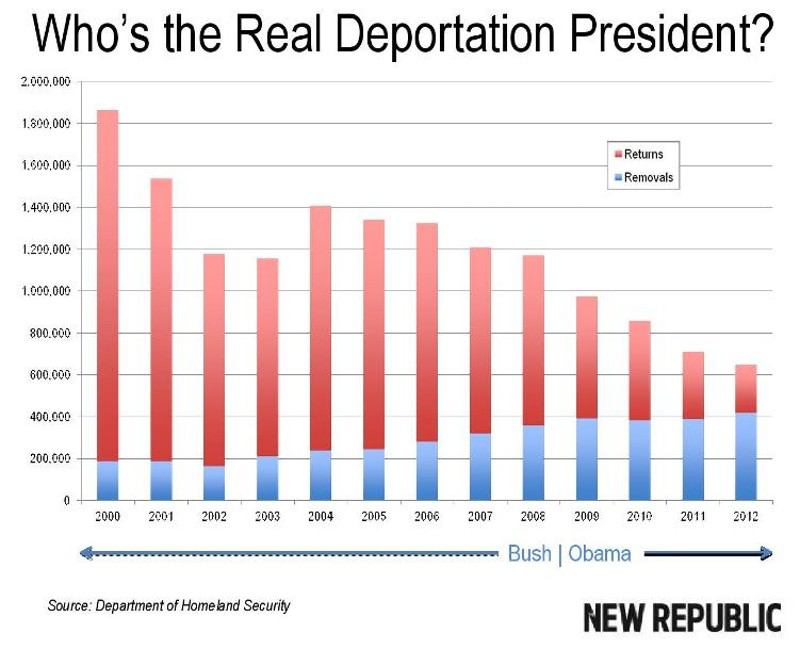In thinking and writing about immigration, it's always advisable to be familiar with your sources. It's important and useful to know for example, that the editorial page and news sections of the Wall Street Journal are different entities, and that news reporters working for the former are proud of their independence and separation from the later.
Moreover, it's not enough to know that the New York Times generally has a liberal slant in both its news and opinion sections. Some reporters there really are independent minded and can be read with more confidence than skepticism. You just have to learn who they are, wherever they write.

You are much more likely to get out-of-the-box thinking on immigration from Ross Douthat, for instance, or Yuval Levin, than from a party-line thinker like Jorge Ramos, who is to immigration journalism what Luis V. ("I have only one loyalty...and that's to the immigrant community") Gutierrez is to divisive partisan politics on the issue.
Of course, most policy-analysis organizations and individuals have a point of view and so a crucial question is how open they are to facts and perspectives that don't accord with their institution's preferred narratives. That's one way to judge whether you are getting the party line, or a real analysis.
Some immigration policy organizations are easy to pigeonhole and deserve it. "Research" emanating from the National Council of La Raza is always an effort to advance their cause. As a result, no "fact" that supports their narrative will be excluded, and no fact that doesn't fit their narrative will be included. It is advocacy pure and simple, and best understood and used with that knowledge.
Others are less obvious and therefore more useful. The Brookings Institution is generally a moderate pro-immigration, center-left organization that can produce very useful reports that reflect a wider range of views than are ordinarily found in advocacy organizations. Their joint Brookings-Duke Immigration Policy Roundtable report was useful precisely for that reason.
Yet, they have their limits. Some viewpoints in the Brookings-Duke immigration "blue-ribbon panel" were conspicuous by their total absence, like support for lowering, or at least not raising, immigration levels. While the official description of the participants pointed with pride to the wide range of views among the panel members, including "restrictionists" who favored lower level of immigration, there was not one dissent to the official position of raising immigration levels as a policy recommendation.
Great minds thinking alike or groupthink? It's hard to know.
An institution's point of view is one thing, an individual's receptivity to facts and perspectives that lie outside of it is another. Some individuals are, for policy-analysis purposes, indistinguishable from their organizations. So, if you want the "good news" about the beneficial effects of high levels of immigration, you can always find it here, or here. Those looking for less cheerleading and more analysis will have to go elsewhere.
Which brings us to the Migration Policy Institute's testimony on the Obama administration's enforcement policies before the Senate Judiciary Committee.
On December 2, 2015, Committee on the Judiciary of the United States Senate held a hearing entitled, "Oversight of the Administration's Criminal Removal Policies". Its purpose was reflected in its title and, as is customary, the committee invited policy experts from a range of perspectives, along with a high-ranking administration official, to discuss immigration enforcement issues and the administration's response to them. The complete three-hour video of the proceedings can be found on the committee's website, along with the prepared statements of each invited expert (including the Center for Immigration Studies' Jessica Vaughan).
A somewhat unusual aspect of this hearing is that one of the invited experts, Dr. Marc R. Rosenblum, Deputy Director of the U.S. Immigration Policy Program at the Migration Policy Institute in Washington, was also invited by Senator Al Franken (D-Minn.) to respond in writing for the record to a series of specific questions put to him, in addition to his prepared remarks.
(Since that hearing Rosenblum has been named Deputy Assistant Secretary at DHS and Director of its Office of Immigration Statistics.)
Most questions have a purpose and who is asking what to whom provides some measure of it. Senator Franken's first question was (emphasis added):
How many individuals have been formally removed by the Obama administration? How many individuals were formally removed by the Clinton and George W. Bush administrations? For each of those administrations, how do the number of individuals formally removed compare to the total number of deportations?
The question is obviously meant to establish a baseline for comparison between the Obama administration, which has been roundly criticized for its enforcement policies, and those of his predecessors. It would be of some political advantage if the Obama administration could be shown to have "formally removed" more illegal immigrants than either Presidents Clinton or Bush. It would then not be so easy to charge his administration with a failure to faithfully carry out the law, or having essentially nullified immigration enforcement.
Rosenblum notes before he presents his data that, "U.S. immigration law provides for two main types of deportations: formal removals (known as formal deportations prior to 1997) and informal returns (also known as voluntary returns or voluntary departures)," and that his analysis includes, "formal removals, informal returns, and total deportations for the Clinton, (George W.) Bush, and Obama administrations."
As the quote above confirms, Rosenblum is aware that, as I wrote last year, that "There is an important distinction between illegal immigrants who are caught and 'returned,' i.e., simply sent back without processing or penalty, and 'removed,' i.e., processed with the penalty of establishing a record that would make their attempted reentry a felony. The more commonly used word 'deportation' refers in most people's mind to a process wherein someone goes before a legal adjudication and is ordered out of the country. When used with that understanding, 'deportation' is it much closer to the formal definition of 'removal' than 'return'." (For DHS definitions of these terms see page 103 footnotes 1 and 2 here.)
Rosenblum writes in the response that his data table includes, "formal removals, informal returns, and total deportations for the Clinton, George W. Bush, and Obama administrations." However, Sen. Franken specifically and more narrowly asked only for information about "formal removals". And it is to that narrowly tailored information that Rosenblum provides his narrative answers.
What's wrong with that?
Plenty, it turns out.
Rosenblum wrote that when you compare the president's "formal removal" record with those of his predecessors, "the Obama administration has formally removed substantially more people than either of its immediate predecessors (and more than any previous administration)." (Emphasis added.)
You can also say, and Rosenblum does:
Looked at as a proportion of total apprehensions, the Obama administration has formally removed 52 percent of the number of people it has apprehended (2.8 million removals compared to 4.7 million apprehensions). By comparison, the Bush administration removed 22 percent of its total apprehensions, and the Clinton administration removed 7 percent."
And you can conclude, as Rosenblum does, in the answer to another Sen. Franken question – "How would you characterize immigration enforcement under the Obama administration, the Clinton administration, and the George W. Bush administration?" – that: "Measured by any reasonable statistics, the Obama administration has been extraordinarily tough on immigration enforcement."
Well, to borrow a meme, that would seem to depend on what the meaning of the words "measurement," "reasonable statistics," and "extraordinarily tough" is.
Sen. Franken's questions to Rosenblum specify those who were "formally removed." Like the good lawyer who doesn't ask a question he doesn't know the answer to, I'm guessing that the narrowly framed question Sen. Franken asked was no accident.
The senator's direct question, and Rosenblum's answers exclude a comparison of "returns," those illegal immigrants who are caught and "returned," i.e., simply sent back without penalty, and "removed," i.e., processed with the penalty of establishing a record that would make their attempted reentry a felony.
The data chart accompanying (see below) a New Republic article on this subject seems to confirm Rosenblum's statement. Beginning in 2008, "removals" – what most people think of when they think of deportations – increased and "returns" saw a substantial decrease.

The problem is that how illegal border crossers are counted has changed, and therefore so has the meaning of the categories into which they are put. As the Los Angeles Times notes (emphasis added), "the number of people deported at or near the border has gone up –primarily as a result of changing who gets counted in the U.S. Immigration and Customs Enforcement agency's deportation statistics."
The vast majority of those border crossers would not have been treated as formal deportations under most previous administrations. If all removals were tallied, the total sent back to Mexico each year would have been far higher under those previous administrations than it is now.
DHS Secretary Jeh Johnson essentially confirmed this fact at a congressional hearing in 2014 (at 1:50):
Rep John Culberson (R–Texas): Under the Obama administration, more than half of those removals that were attributed to ICE [Immigration and Customs Enforcement] were actually the result of Border Patrol arrests. They wouldn't have been counted in prior administrations.
Jeh Johnson: Right.
Even President Obama acknowledged, before a limited, mostly Hispanic audience, the deceptive nature of the new counting method back in 2011 (emphasis added):
the statistics are actually a little deceptive because what we've been doing is with the stronger border enforcement we've been apprehending folks at the borders and sending them back. That is counted as a deportation, even though they may have only been held for a day or 48 hours, sent back – that's counted as a deportation.
In other words, Sen. Franken's question that specifically asks about "formal removals" as the basis for comparing the Obama's administration's enforcement record with the record of his predecessors puts a rather heavy thumb on the scale.
And, by not saying what it's safe to assume he knows, Rosenblum did the same thing.
